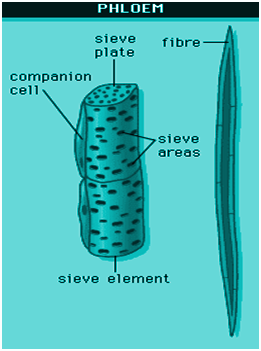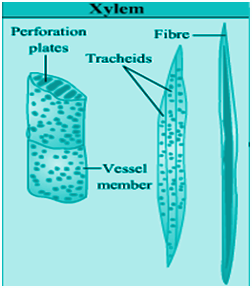Anatomy is the study of the internal structure of an organism. Plant Anatomy is mainly related to the structure and study of an organisation of tissues. A tissue is defined as “a group of similar or dissimilar cells having a common origin and performing a specific function.” There are mainly three types of tissues, namely secretory tissue, permanent tissue, and meristematic tissues or meristems. In plants, they are two types of tissue, meristematic tissues or meristems and permanent tissue.
Permanent Tissues
They are two types of permanent tissues, namely complex and simple tissue.
Complex Tissues: It consists of phloem and xylem.
Phloem comprises the following components:
- Fibres of phloem provide mechanical strength to the plant.
- Sieve tubes have perforated ends, that is, they are slender cells placed end to end.
- Phloem parenchyma are living cells that store food.
- Companion cells are elongated cells. They are absent in gymnosperms and usually found in angiosperms.

Xylem consists of four elements, and they are as follows:
- Xylem parenchyma are living cells that store fats and starch.
- Tracheid is dead cells with lignified and hard walls. They have blunt ends that help in the conduction of water in plants.
- Xylem fibres are lignified with pointed ends, which help in the conduction of nutrients and water from the root to the leaf.
- Vessels are tube-like structures which are dead at maturity. They provide mechanical support to the plant and are involved in the transport of water.

Simple Tissues
Simple tissues are of three types, and they are listed below:
- Collenchyma: They are living cells with chloroplasts for photosynthesis.
- Parenchyma: They are simple and unspecialised cells. They are found in Cortex, Pith, Pericycle and Epidermis. They are involved in the storage of food, photosynthesis, etc.
- Sclerenchyma: These cells are lignified, long cells with a tapering end. They are dead cells and are involved in mechanical function.
Meristematic Tissue
Meristematic tissue is defined as a group of cells that have the capability of division. There are three types of meristem. Intercalary meristem is found on the leaf blades and base of the nodes. Apical meristem is present on the apices of the root and shoot. Lateral meristem helps plants to grow laterally. Apical meristem is found in the shoot, root or at the tips of the plant. They are regarded as actively dividing cells.
Comments